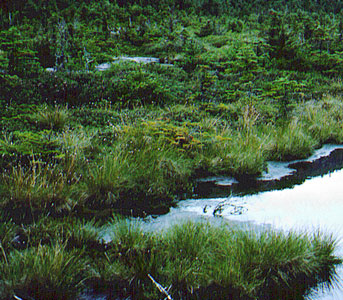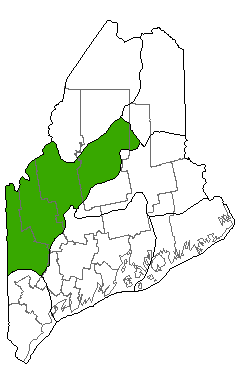DACF Home → Bureaus & Programs → Maine Natural Areas Program → Communities, Plants, and Animals → Natural Community Fact Sheets → Alpine Bog
Printer Friendly Fact Sheet - 1.3 MB pdf (Get a free copy of Adobe Acrobat Reader)
Alpine Bog
Scientific Name: Cotton-grass - Heath Alpine Bog; State Rank: S1

- Community Description
- Soil and Site Characteristics
- Diagnostics
- Similar Types
- Conservation, Wildlife and Management Considerations
- Distribution
- Characteristic Plants
- Associated Rare Plants
- Associated Rare Animals
- Examples on Conservation Lands You Can Visit
Community Description: Peat mosses form a carpet on which dwarf bog shrubs and herbs are scattered. The herb layer generally totals 25-40% cover and consists of patches of graminoids such as deer-hair sedge and tufted cotton-grass interspersed with patches of dwarf heath shrubs: bilberries, crowberry, Labrador tea, leatherleaf, rhodora, and sheep laurel (the latter less abundant here than in other dwarf shrub bog vegetation types). A few islands of stunted balsam fir and black spruce may be present. Small cranberry and roundleaved sundew grow on the peat moss. Baked apple-berry is frequent and is restricted in Maine to these alpine bogs and Downeast peatlands. Back to top.
Soil and Site Characteristics: These wetlands occur in alpine or subalpine settings near or above treeline. Sites are usually level, in small bedrock depressions, or slightly sloping on the edge of basins. The substrate is permanently saturated organic soil. Unlike its lower elevation counterparts, these bogs often have lenses of peat beneath the vegetation that remain frozen well into the growing season. Back to top.
Diagnostics: This type occurs near or above treeline on a saturated substrate. Peat mosses exceeds cover of other vegetation, with reindeer lichens essentially absent. Shrubs include lower-elevation species as well as the more restricted bilberry and crowberry. Herbs are mostly graminoids. Back to top.
Similar Types: The montane setting differentiates this from other peatland community types. The Sphagnum substrate differentiates it from other high-elevation types, except for Subalpine Hanging Bogs, which occur on steeper slopes (>20%), have the dwarf shrub - herb cover exceeding bryoid cover, have more krummholz (spruce, fir, or cedar) and fruticose lichens, and usually lack deer-hair sedge and cotton-grass. Both types are floristically similar to certain coastal raised peatlands and Maritime Slope Bogs. Back to top.
Conservation, Wildlife and Management Considerations: The few known Maine occurrences of this type occur on public or private conservation land; hiker traffic has caused degradation in heavily used areas. As with all alpine vegetation in Maine, careful trail siting and efforts to minimize off trail use are the important management considerations. In these alpine wetlands, boardwalks or log crossings are helpful.
This high elevation bog community provides potential habitat for the rare northern bog lemming. Back to top.


Distribution: Montane western Maine, extending westward into New Hampshire and possibly northeasterly to the Gaspé Peninsula. Landscape Pattern: Small Patch. Back to top.
Characteristic Plants: These plants are frequently found in this community type. Those with an asterisk are often diagnostic of this community.
- Dwarf Shrub
- Alpine bilberry
- Baked apple-berry
- Black crowberry*
- Labrador tea
- Leatherleaf*
- Pale laurel
- Small cranberry*
- Herb
- Bog sedge*
- Deer-hair sedge*
- Few-flowered sedge*
- Round-leaved sundew
- Tufted cotton-grass*
- Bryoid
- Cetraria lichen*
- Fen sickle-moss*
- Sphagnum mosses*
- Northern bog lemming
Examples on Conservation Lands You Can Visit
| Example | County |
|---|---|
| Mahoosuc Public Lands | Oxford Co. |
| Saddleback Mountain, Appalachian Trail | Franklin Co. |